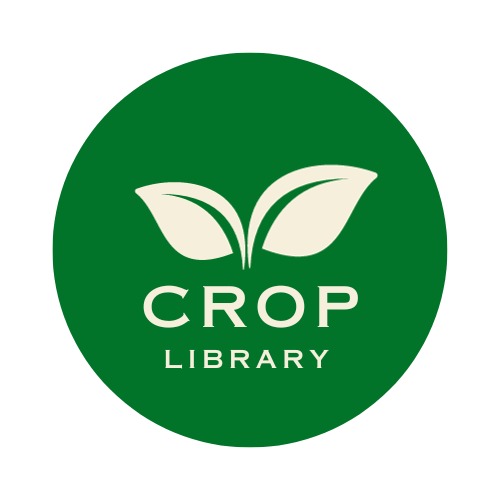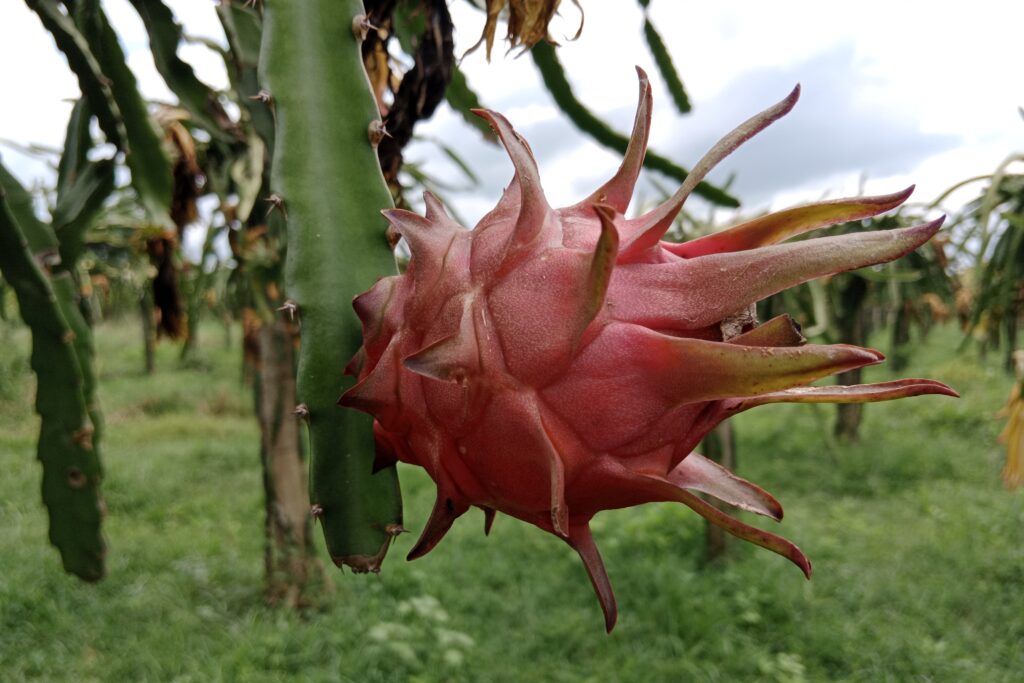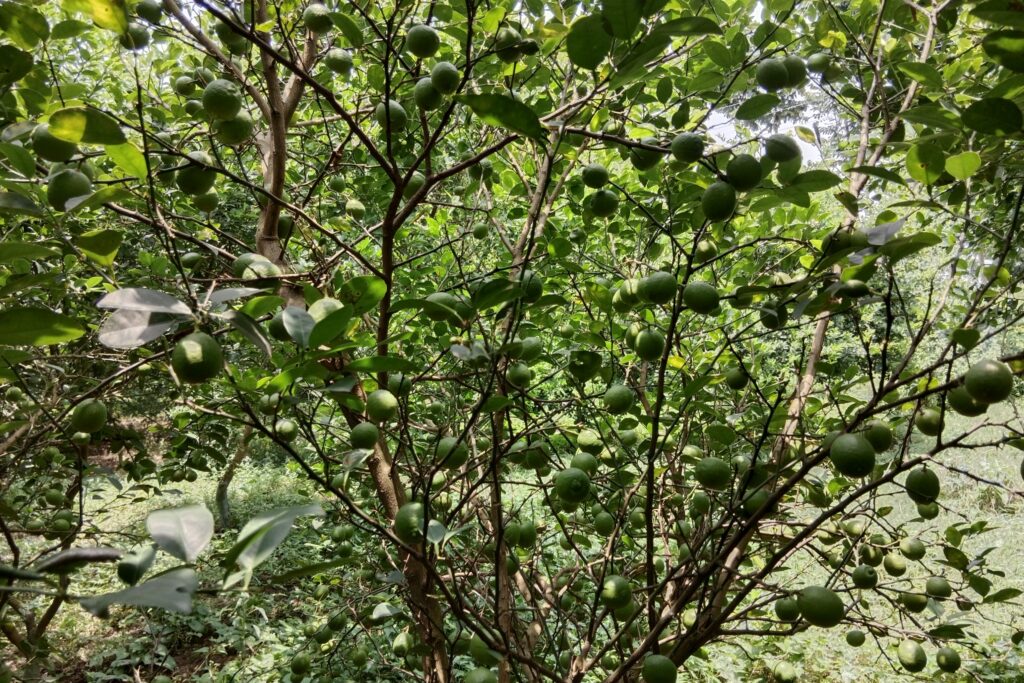Rosemary Farming
Rosemary, known scientifically as Rosmarinus officinalis, is a fragrant evergreen shrub that originates from the Mediterranean area. As a perennial plant, it is recognized for its resilience and can yield harvests for an extended period once it has taken root. Its aromatic leaves are prized both as a fresh or dried culinary seasoning and as a source of essential oil, which is widely utilized in fragrances, beauty products, and therapeutic aromatherapy practices.
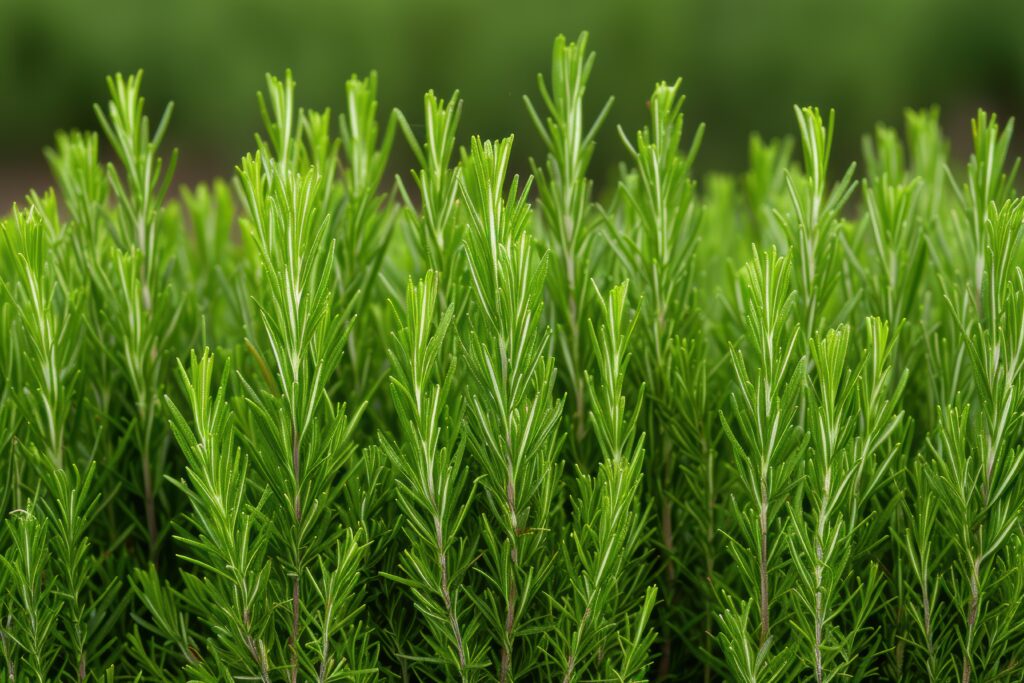
For farmers seeking a high-value agricultural venture, understanding the potential rosemary farming profit per acre is crucial. While farmers generally face a net loss of around NRs. 26,000 in the first year due to high establishment costs and low yields, the crop stabilizes remarkably in the second year to generate a net profit of about NRs. 150,000, effectively recovering the initial loss.
From the third to the fifth year, rosemary reaches peak productivity, yielding consistent annual profits of approximately NRs. 220,000, while from the sixth year onward the yield slightly declines to 3,500 kg per acre, still providing a strong profit of about NRs. 185,000 annually.
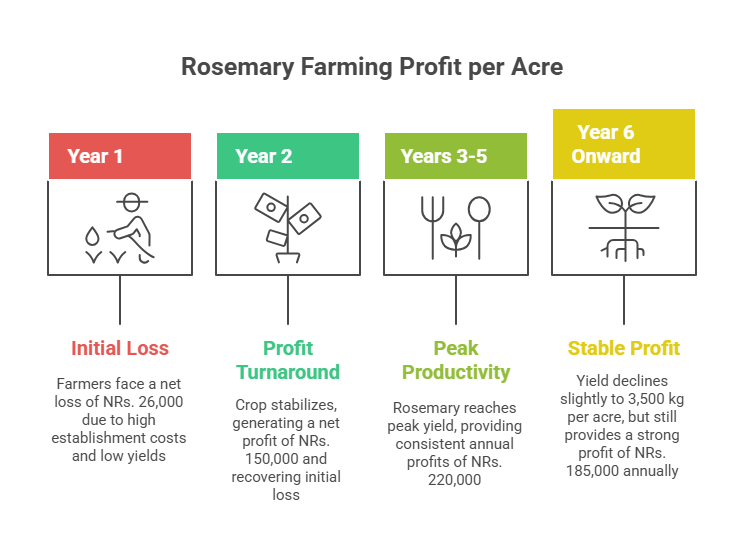
The return on investment is achieved in the second year, and over a five-year period the total net profit can reach around NRs. 784,000, making rosemary farming a sustainable and highly lucrative long-term investment.
Land Preparation
Land preparation aims to create a loose, well-aerated, and weed-free seedbed that supports strong root development. The process begins with deep plowing or sub-soiling to a depth of 30–40 cm to break any hardpan and improve soil drainage.
After plowing, the soil is left to weather for one to two weeks before undergoing 2–3 cross harrowings to break down large clods and level the field. The final tilth should be fine, crumbly, and free from weeds, stones, or crop residues. In regions with heavy rainfall or poor drainage, raised beds about one meter wide are recommended to minimize waterlogging around the roots.
Soil Type
Rosemary grows best in well-drained sandy loam or loamy soils with good aeration, as its roots are highly prone to rot in waterlogged conditions. The ideal soil pH ranges from 6.0 to 7.5, slightly acidic to neutral, though the plant can also tolerate moderately alkaline soils and even thrive in poor, rocky soils similar to its native habitat.
Proper drainage is the most critical factor for successful cultivation, and heavy clay soils should be avoided unless they are well amended with sand and organic matter.
Climatic Requirements
Rosemary thrives best in a warm, sunny, Mediterranean-like climate, with an optimal temperature range of 15°C to 30°C. While it can tolerate light frosts once established, it is not winter-hardy in severe cold, and extreme heat above 40°C may cause stress. The plant requires full sun exposure of at least 6–8 hours daily to ensure vigorous growth and high essential oil content. Being drought-tolerant, rosemary prefers dry conditions and grows well with annual rainfall of 500–800 mm, though excessive humidity or prolonged rain can increase the risk of fungal diseases.
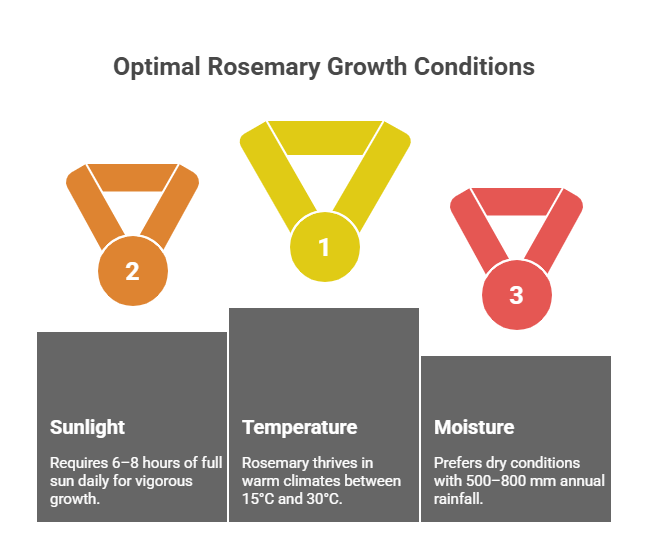
Major Cultivars
| Cultivar Name | Key Characteristics |
| Arp | Exceptional cold hardiness |
| Tuscan Blue | Upright growth, strong flavor, vibrant blue flowers |
| Spice Islands | Commercial favorite for high essential oil yield and strong aroma |
| Prostratus (Trailing) | Low-growing, spreading variety; used for ornamental ground cover |
| Miss Jessop’s Upright | Very tall, vigorous upright variety |
| Gorizia | Large-leafed cultivar with a mild, sweet flavor |
Propagation
Rosemary is primarily propagated vegetatively to ensure the true characteristics of a cultivar, with stem cuttings being the most widely used method. Semi-hardwood cuttings, 10–15 cm in length, are taken from healthy, disease-free mother plants, with the lower leaves removed and the base treated with rooting hormones such as IAA or IBA before planting in the nursery.
Seed propagation is less common due to its low and inconsistent germination rates (often only 30–50%) and slow seedling growth, making it unsuitable for commercial cultivation since the offspring may not remain true-to-type.
Seed Rate per Acre
In commercial rosemary farming, seed rate is generally not applicable since propagation relies on cuttings rather than seeds. Instead, around 15,000 to 20,000 rooted cuttings are required per acre, depending on the spacing adopted.
Nursery Management
Nursery management for rosemary involves preparing a well-draining rooting medium, usually a mix of soil, sand, and compost or coco peat. Treated cuttings are inserted into this medium in raised nursery beds or propagation trays under a 50% shade net.
High humidity should be maintained through regular misting, ensuring the medium remains moist but not waterlogged. Rooting generally occurs within 3–5 weeks, and the cuttings become ready for transplanting once a strong root system has developed, typically after 8–10 weeks in the nursery.
Planting
a). Planting Season
The ideal planting season for rosemary is at the onset of the monsoon or during spring, typically around June–July or February–March in many regions, as these periods provide sufficient soil moisture for establishment without the risk of excessive water.
b). Spacing
| Purpose | Spacing (Row to Row x Plant to Plant) | Description |
| For Herb Production | 90 cm x 60 cm | Allows for bushy growth and easy harvesting. |
| For Oil Production | 60 cm x 45 cm | Denser spacing to maximize biomass yield per acre. |
c). Pit Preparation
Dig pits of 15 cm x 15 cm x 15 cm at the marked spacing.
d). Planting Method
Mix the excavated soil with 1-2 kg of well-decomposed Farm Yard Manure (FYM) and a handful of neem cake. Place the rooted cutting in the center of the pit, fill it with the soil-manure mix, and press firmly. Water immediately after transplanting.
To encourage healthy bushy growth in rosemary, the central shoot should be removed approximately six months after planting. This practice redirects the plant’s energy from vertical growth to the development of lateral shoots, resulting in a fuller, more productive plant structure.
Removing the central shoot also improves air circulation within the canopy, reduces the risk of diseases, and enhances overall growth vigor, ultimately supporting higher yields and better quality foliage.
e). Number of Plants per Acre
With a spacing of 60 cm by 45 cm, approximately 14,988 rosemary plants can be planted per acre.
Intercropping
In the first year, before rosemary bushes develop a full canopy, low-growing and non-invasive crops such as leafy greens (lettuce, spinach), radishes, and spring onions can be intercropped to make efficient use of land. However, intercropping should be discontinued after the first year, as the maturing rosemary plants will completely shade the ground.
Irrigation
When rosemary is first transplanted, it should be watered right away and then given light irrigation every three to four days during the initial month to help the roots establish. After about two months, once the plant is settled, it develops strong drought resistance and should only be watered once the soil has dried out completely.
A common mistake is watering too often, but rosemary responds better to occasional deep watering—generally every two to three weeks, depending on the climate and soil type—than to frequent, shallow watering. Using a drip irrigation system is especially effective because it provides water directly to the roots, reduces waste, and keeps the leaves dry, which lowers the risk of disease.
Fertilizer and Manure
Rosemary is not a heavy feeder and thrives in moderately fertile soil.
| Application Stage | Fertilizer Type | Quantity per Acre | Notes |
| Land Preparation (final plough) | Well-rotted FYM or Compost | 10 – 15 tonnes | Incorporate into the soil during land preparation. |
| Azospirillum | 800 g | Apply together during land preparation. | |
| Phosphorus Solubilizing Bacteria (PSB) | 800 g | ||
| Potash Mobilizing Bacteria | 800 g | ||
| Basal dose | Chemical Fertilizers (Basal) | Apply half of the Nitrogen and all of the Phosphorus and Potash. | |
| – N (Nitrogen) | 25 kg | (Half of the total 50 kg N) | |
| – P₂O₅ (Phosphorus) | 40 kg | (Full dose) | |
| – K₂O (Potash) | 40 kg | (Full dose) | |
| After First Harvest | Chemical Fertilizers (Top Dressing) | Apply the remaining half dose of Nitrogen. | |
| – N (Nitrogen) | 25 kg | (Remaining half of the total 50 kg N) | |
| Subsequent Years | Full NPK Dose | 50 kg N, 40 kg P₂O₅, 40 kg K₂O | For established perennial stands. Apply annually after the main harvest. |
Weed Control
Early Control
Weed management is most critical during the first one to two months after planting, as young rosemary plants are highly sensitive to weed competition. To maintain healthy growth, four to five weeding sessions should be carried out throughout the year.
Mechanical Methods
Weeds can be controlled through shallow hoeing or hand-pulling, which effectively removes them without harming the shallow root system of rosemary. Deep cultivation should be avoided to prevent root damage.
Mulching
Applying mulch such as straw, dry leaves, or black plastic around the plants is highly beneficial. Mulching not only suppresses weed growth but also helps retain soil moisture and regulates soil temperature.
Chemical Control (Optional)
For growers opting for chemical methods, pre-emergent herbicides like Pendimethalin can be applied before weed germination. The recommended dose is 1 liter of active ingredient per acre, diluted in 150–200 liters of water. Strict adherence to label instructions is essential to avoid any potential harm to the crop.
Inter Culture Operation
Pruning
Pruning is an essential practice for maintaining plant shape, encouraging bushy growth, and preventing the development of a leggy, woody structure. This process begins with a first pruning when plants reach about 15 cm in height, where the growing tips are pinched back to stimulate lateral branching. Subsequently, after each major harvest, an annual hard prune should be performed, removing approximately one-third of the current season’s growth to promote fresh, vigorous shoots for the next cycle.
Training
In the case of upright varieties, training requirements are minimal. The primary goal is simply to maintain a neat, compact, and productive bush that is easy to manage and harvest.
Flowering and Fruit Management
Rosemary usually flowers in late winter or spring, producing blossoms that attract bees and aid in pollination. While flowering is not a major factor for leaf and oil production, as most essential oils are concentrated in the leaves, the flowers also contain some oil. For growers focused on maximizing leaf yield, removing flower buds as they appear helps redirect the plant’s energy toward vegetative growth, resulting in healthier foliage and higher productivity.
Pest and Disease Management
Rosemary is notably pest and disease-resistant when grown in proper conditions.
Common Pests
Aphids and Spider Mites
Aphids and spider mites are occasional pests, particularly affecting rosemary plants that are dry or stressed. They can be effectively managed by spraying the plants with a strong jet of water to dislodge the pests, or by applying neem oil or insecticidal soap. These treatments help reduce pest populations while being safe for the plant and the environment.
Root-Knot Nematodes
Root-knot nematodes can pose a problem in poorly managed or infested soils, causing stunted growth and the formation of root galls. Preventive measures include practicing crop rotation to disrupt the nematode life cycle and applying neem cake to the soil, which acts as a natural nematicide and improves soil fertility.
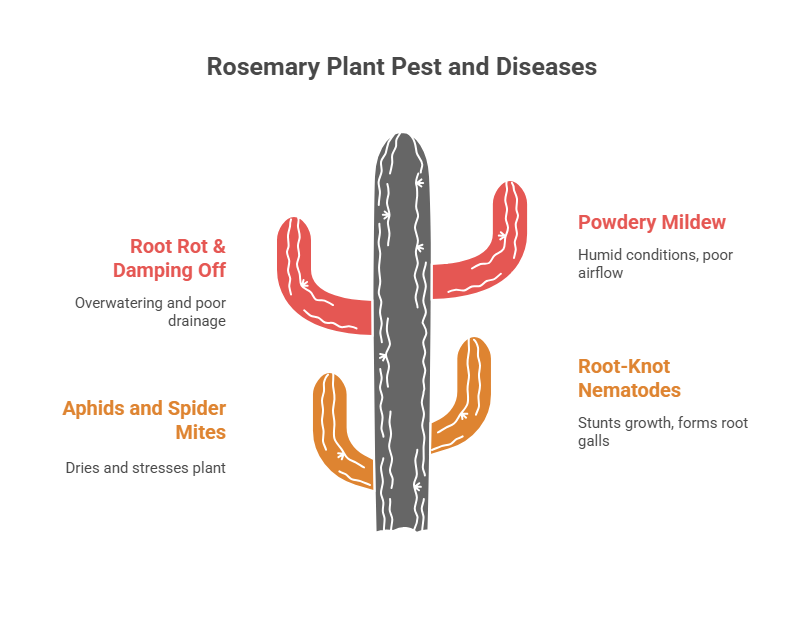
Common Diseases
Root Rot & Damping Off (caused by Pythium and Phytophthora)
This is the most serious disease, primarily caused by overwatering and poor drainage. As there is no cure once the plant is established, prevention is absolutely key. The primary control method is to ensure excellent drainage and avoid waterlogging entirely. For preventative chemical control, drenching the soil with a fungicide such as Mancozeb (0.3%) or Captan (0.2%) at the seedling stage can be effective.
Powdery Mildew
This fungal disease appears as distinctive white, powdery spots on leaves, thriving in humid conditions with poor air circulation. Cultural practices like improving air flow around plants are crucial for management. For treatment, apply a sulfur-based fungicide like Wettable Sulphur (0.3%). Alternatively, other effective options include Hexaconazole (0.1%) or a ready-to-use neem oil-based bio-fungicide, following the manufacturer’s instructions.
Harvesting
The first light harvest of rosemary can be carried out 6–8 months after planting, while full productivity is typically reached from the second year onward. Harvesting is best done in the morning after the dew has dried but before the sun becomes intense, as this timing ensures the highest essential oil content.
A sharp, clean knife or shears should be used to cut the stems. For the fresh herb market, tender green tips measuring 10–15 cm are ideal, whereas larger, woody branches can be harvested for oil extraction. It is important to always leave at least one-third of the plant intact to support healthy regrowth.
Yield
Rosemary yield varies depending on the cultivar, plant age, climate, and management practices. For fresh herbs, the first-year yield ranges from 1,000 to 1,500 kg per acre, increasing to 3,000–5,000 kg or more per acre from the second year onward under optimal conditions.
When dried, the herb has a fresh-to-dry ratio of approximately 4:1 to 5:1, resulting in an annual dry yield of about 600–1,000 kg per acre from a mature plantation. The essential oil content of rosemary ranges from 0.5% to 1.2% of fresh weight, which translates to an expected yield of roughly 15–40 kg of essential oil per acre per year.
Cost of Investment per Acre for Rosemary Farming
| S.N. | Category | Cost (NRs.) |
| 1 | Land Preparation | 15,000 |
| 2 | Planting Material (Stem Cuttings) | 15,000 |
| 3 | Planting | 6,000 |
| 4 | Fertilizers and Manure | 13,000 |
| 5 | Irrigation | 15,000 |
| 6 | Weed Control (Pre & Post-Emergence) | 7,000 |
| 7 | Pest & Disease Control | 8,000 |
| 8 | Harvesting | 7,000 |
| 9 | Miscellaneous Costs | 10,000 |
| Total Cost | 96,000 |
Annual Maintenance Cost Per Acre for Rosemary Farming
The annual maintenance cost for rosemary cultivation is estimated at around NRs. 60,000 per acre, which covers essential activities such as irrigation, application of fertilizers and organic manure, weed management, pest and disease control, pruning, and harvesting operations. This recurring expense ensures the healthy growth and productivity of the crop, supporting consistent yields and sustained profitability over the years.
Income Per Acre for Rosemary Farming
| Year | Estimated Yield (Kg/Acre) | Market Price (NRs./Kg) | Total Income (NRs.) |
| 1st Year | 1,000 | 70 | 70,000 |
| 2nd Year | 3,000 | 70 | 210,000 |
| 3rd – 5th Year | 4,000 | 70 | 280,000 |
| 6th Year onwards | 3,500 | 70 | 245,000 |
Analysis of Rosemary Farming Profit Per Acre
| Year | Total Income (NRs.) | Total Costs (NRs.) | Net Profit/Loss (NRs.) | Cumulative Profit (NRs.) |
| 1st Year | 70,000 | 96,000 + 60,000 = 156,000 | -86,000 | -86,000 |
| 2nd Year | 210,000 | 60,000 | +150,000 | +64,000 |
| 3rd Year | 280,000 | 60,000 | +220,000 | +284,000 |
| 4th Year | 280,000 | 60,000 | +220,000 | +504,000 |
| 5th Year | 280,000 | 60,000 | +220,000 | +724,000 |
| 6th Year | 245,000 | 60,000 | +185,000 | +909,000 |
Farmers generally face a net loss of around NRs. 26,000 due to high establishment costs and low yields, but by the second year the crop stabilizes and generates a net profit of about NRs. 150,000, effectively recovering the initial loss.
From the third to the fifth year, rosemary reaches peak productivity, yielding consistent annual profits of approximately NRs. 220,000, while from the sixth year onward the yield slightly declines to 3,500 kg per acre, still providing a strong profit of about NRs. 185,000 annually.
The return on investment is achieved in the second year, and over a five-year period the total net profit can reach around NRs. 784,000, making rosemary farming a sustainable and highly lucrative long-term investment.
Sources
Food and Agriculture Organization (FAO)
University of California Agriculture & Natural Resources (UC ANR)
European Plant Protection Organization (EPPO)
Punjab Agricultural University (PAU)
Tamil Nadu Agriculture University (TNAU) – Agritech portal
Indian Council of Agricultural Research (ICAR)
Nepal Agricultural Research Council (NARC)
U.S. Department of Agriculture (USDA).
Ministry of Agriculture and Livestock Development (Nepal)
Disclaimer: This crop farming profits assume optimal conditions. Actual results may vary depending on climate, market prices, and farm management practices.
